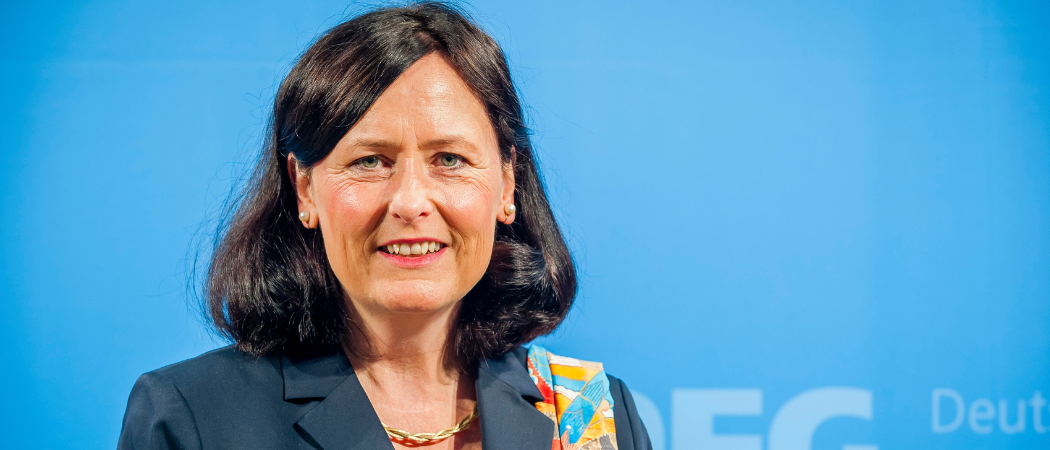The strategy aims to ensure German science excels internationally. It has worked well for the biggest hitters - but many worry universities in former East Germany are being left behind

German Research Foundation (DFG) president Katja Becke. Photo: DFG
Universities across Germany will compete over the summer for the next round of funding from the multi-million excellence strategy fund, which was launched in 2019 to fund compelling research projects and strengthen the international standing of German science.
Now midway through its first seven-year phase, the German Research Foundation (DFG) which manages the fund is sifting 143 proposals from 59 universities across all 16 federal states to decide which projects to back next.
In their proposals universities organise themselves into consortia, or ‘clusters of excellence’. As one example, in 2019 the universities of Bonn, Aachen and Cologne were awarded funding to study light technology for quantum computing.
A key objective of the excellence strategy is to encourage universities to modernise their administration and proposals need to present convincing plans for both the research project and strategies on governance, teaching and human resources.
Clusters and universities
Unlike Germany’s nascent tech transfer agency, applicants don’t need to promise new technologies or spin-offs for the market. “The excellence strategy is primarily aimed towards furthering excellence in basic research,” DFG president Katja Becker told Science|Business. “A proposal does not need to be aimed towards ‘transfer’ to be judged excellent and [to be] funded.”
Successful clusters in the latest round of awards will get €3 - €10 million annually over seven years, starting in January 2026. The competition is tough: only 70 clusters will receive funding and 57 clusters which have been running since 2019 will have to reapply to continue their work for the next seven years.
Up to €539 million is available for the clusters each year, paid through Germany’s federal and state governments. Universities participating in two or more successful clusters also qualify to become a University of Excellence, giving them access to a €148 million fund managed by the German Council of Science and Humanities.
East-west split
Though the current excellence strategy launched in 2019, its origins lie in an earlier fund called the Excellence Initiative, which ran from 2005 until 2018. This also encouraged university reforms and funding for university clusters and individual universities, and in addition included a funding programme for graduate students.
However its shortcomings became clear in a 2016 report which found the multiple goals and excessive paperwork required by the initiative had led to separate specialised units being created within universities, adding extra burdens to university leadership, while funding for graduate students led to a swell of temporary postdoc positions.
Some of the report’s recommendations made it into the 2019 excellence strategy which did away with excessive goals and instead focused on boosting the international competitiveness of German research and universities. Geographically distant universities could now apply to become clusters, and the criteria to become a University of Excellence was simplified.
Since its 2019 launch universities funded through the excellence strategy have in general been positive about their experience. But worries remain that universities are dedicating too many resources to chasing limited funding. One German publication estimates that universities have spent €150 million in applications for the excellence strategy, with less than half being successful.
This figure underpins concerns that only rich universities in Germany’s western states can handle the bureaucracy. Of the eleven universities announced as Universities of Excellence in 2019, only TU Dresden is in the former East Germany.
Politicians were quick to point this out. “There is the problem of the East being left behind,” said Thomas Sattelberger, former research spokesman for the liberal FDP party. “All other east German universities had no chance from the beginning.” East German members of Angela Merkel’s then-coalition government also suggested ‘corrections’ to the excellence strategy to help eastern universities succeed.
Pushback from students
This criticism is something DFG acknowledges. “The distribution of excellence funding across the country is certainly an issue that all stakeholders are aware of, not least the federal and state governments,” said Becker.
Others worry the excellence strategy is creating a two-tier system in German universities, with those awarded University of Excellence gaining an unfair advantage in other funding areas. A 2021 study of the earlier excellence initiative found they got a short boost in third party funding at the beginning, though it then levelled off to previous rates.
The most vocal critics of the excellence strategy are students. Several regional student organisations have criticised it for ignoring teaching in its assessments of universities, and of an unfair distribution of research funds.
“The federal government's excellence strategy aims to put an infinitesimally small number of universities in a better long term position than the large remainder,” the student body of Albert-Ludwigs-Universität Freiburg told Science|Business. It instead asks for basic funding for all universities, to reverse the trend towards elite funding. “Previous requests for reform from students have gone unheard by the government. The voices of students, without whom universities would no longer have a raison d'être, are largely ignored in the discourse.”
In a joint article published in a leading political culture magazine, board members of the Federal Student Council put forward three central criticisms of the strategy; the east-west split; underfunding for unsuccessful applicants; and universities diverting too many resources to the application process. The pressure to get excellence strategy funding means “universities are turning from educational institutions into application workshops,” the council said.
The excellence strategy has seen changes since its launch. Applicants for upcoming funds can now discuss their proposal directly with the review panel during the draft review process. Becker says this change came from feedback after the first funding phase, because universities felt it would increase the quality of reviews. To prevent any undue lobbying, these meetings will also be attended by DFG staff and members of the committee of experts who will choose which proposals make it to the next round.
The number of clusters and Universities of Excellence are also expanding. During talks earlier this year at the Joint Science Conference, science and finance ministers of the federal and state governments formally agreed to raise the number of eligible clusters to 70. In the future the number of Universities of Excellence could be raised to 15.
Universities applying for the next phase of funds will get the final answer in May 2025, when the committee of experts and federal & state research ministers announce which new clusters of excellence will be set up and which will continue to receive funding.
DFG says that it will continue consulting with universities for ideas to update or reform the strategy. This includes on-site visits to universities, online events and phone calls and emails with individuals.
“The input from all of these interactions has made its way into our plans and procedures for the second competition phase,” Becker said. “The added interaction between applicants and reviewers […] is a good example of this.”





 A unique international forum for public research organisations and companies to connect their external engagement with strategic interests around their R&D system.
A unique international forum for public research organisations and companies to connect their external engagement with strategic interests around their R&D system.